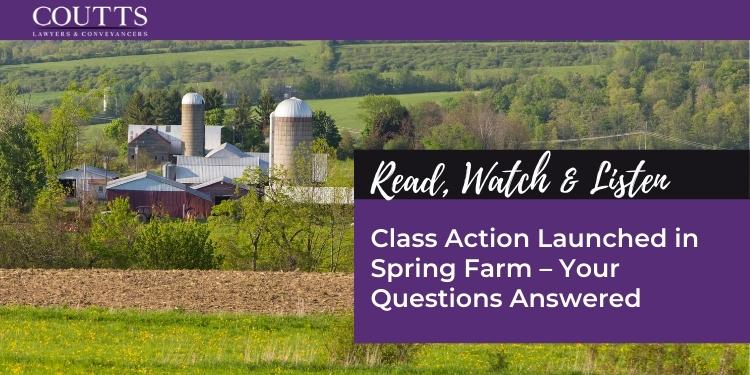KEY TAKE OUTS
- It was recently reported that a class action for homeowners in Spring Farm was launched in May 2021, naming Camden Council, the developers Cornish Group Farm Pty Ltd, and the geotechnical engineers as defendants in a claim in negligence and misleading and deceptive conduct.
- Residents allege they have suffered experienced significant cracks in their homes, with glass suddenly shattering due to shifting of the earth beneath.
- The suburb was developed atop a former chicken farm and is argued to not have been filled or compacted properly.
- The law firm that is leading the class action is Mayweathers, requires interested applicants or homeowners to return applications to participate in the class action by 30 June 2021.
- This article will provide a brief “Q&A approach” to class actions, to assist our local clients considering joining the Spring Farm class action.
The Spring Farm Class Action – a brief summary
A class action for homeowners in Spring Farm was launched in May 2021, naming Camden Council, the developers Cornish Group Farm Pty Ltd, and the geotechnical engineers as defendants in a claim in negligence and misleading and deceptive conduct. A class action is a lawsuit filed (or defended) by seven or more individuals, where the claims arise out of the same, similar, or related circumstances and give rise to a substantial common question of law or fact. Class actions are generally funded by litigation funders, on a ‘no win, no fee’ basis.
The Spring Farm class action will claim damages against Camden Council, the developer Cornish Group Spring Farm Pty Limited and the geotechnical engineers, SMEC Testing Services Pty Limited, and SMECTS Holdings Pty Limited. The litigation is on behalf of any current or former owners, purchasers, landlords, investors, and authorised representatives of deceased estates. The action currently encompasses all 3,500 homes of Spring Farm, even if unaffected, citing the damaged reputation and lowered market value of the area.
The issues faced by the residents are claimed to have been triggered after the land was not filled and compacted properly. The soft land means new homes have begun to crack and fall apart as the earth shifts below, making homes ‘unfit for residential development’. The movement is blamed on years of sand mining that occurred before the suburb was established, which is now built on a former chicken farm.
Many Spring Farm residents and homeowners have received the enclosed invitation to register their interest in the class action.
If you wish to be involved in the Spring Farm class action, you must register your interest to be considered a class member. This is done by completing the application, and submitting it, directly to the law firm heading the class action, Mayweathers. The link can be found here.
Applications must be submitted by 30 June 2021.
What is a Class Action?
A class action is formally known as a “representative proceeding”. A class action is a court proceeding where the claims of a group or ‘class’ of persons are brought by one, or small number, of named representative.
In NSW, class actions can only be commenced where the following tests are met:
- where there are seven or more people who have claims against the same person or entity;
- the claims arise out of the same, similar or related circumstances; and
- the claims must all give rise to at least one substantial common issue of law or fact.
Who can bring a Class Action?
Class actions are generally commenced by a single class representative, who is named and listed as the applicant in the proceedings. This single representative brings the proceedings on behalf of all of the class members (however, there can be more than one class representative, and if this occurs, both class representatives become the applicant in the proceedings).
The class members (the individuals who are participating in the proceedings) are not listed by name in the documents that commence the proceedings, and largely play a “passive” role in the litigation.
What happens if I “opt-in” to the Class Action?
The law firm that generally heads up the class action can define the class as either an “open” or “closed” class. An “open” class means a class action in which the members of the class are not known to the law firm or litigation funder, whereas a “closed” class action is an action where all the class members are known to the law firm or litigation funder.
Whether a class is an open or closed class affects if the action follows an “opt-in” or “opt-out” model.
The Australian class action regime utilises an “opt-out” model, which means:
- all potential claimants fall within the definition of a class (and therefore become a member of the class) whether they are aware of it or not;
- all class members are bound by any judgment by the Court, or any settlement approved by the court, unless they opt-out of the proceedings before a date (which is fixed by the court);
- if a class member chooses to opt-out, they will no longer be bound by the outcome of the proceedings and will be able to pursue their own claim in a separate proceeding.
If a class action is defined as a “closed” class however, the “opt-in” model applies, which requires potential class members to positively indicate that they want to participate and be a member of the class. If a potential claimant does not “opt-in” to be a part of the class, they will not become members of the claim and will therefore not be bound by any judgment or settlement.
If I am a part of a successful class action, what happens with the money if we win?
Settlements of class actions are generally the most common way in which class actions are resolved. When a class action is settled, the settlement monies must be distributed amongst the class members who have suffered loss. The settlement funds are first paid into a fund, that is held on trust, until the distribution process can occur. The settlement distribution process must also be approved by the court, and is guided by two factors, being compensation on the merits of each case, and, efficiency.
The first factor, being compensation on the merits, focuses on the substantive law surrounding the claim and the underlying compensation principle. This factor is guided so that each distribution of the settlement fund is calculated in a way that each group member receives compensation commensurate with the amount to which they are entitled (based on their individual circumstance).
The second factor however, being efficiency (and also known as ‘rough justice’), contradicts the first factor and requires the distribution process to be completed in a manner the minimises further legal costs and delay. This factor involves simplifying the distribution process to make it less costly and quicker, potential ignores some group member circumstances relevant to the quantum of the recovery that should be made.
Exactly how these two factors and requirements are met during a distribution process depends on each class action. For example, in the ‘Black Saturday’ class action case that was launched by the law firm Maurice Blackburn, the court approved of the funds to be distributed once Maurice Blackburn administered an assessment of each individual members’ claims. This was completed by each claimant completing a questionnaire regarding their personal injury or property claim, with a team of barristers and/or medical experts assessing this information to arrive at a figure for each member. The settlement monies were then divided on a pro-rata basis between the class members in accordance with a settlement scheme that was approved by the court.
Contact Coutts Lawyers & Conveyancers office today.
This blog is merely general and non-specific information on the subject matter and is not and should not be considered or relied on as legal advice. Coutts is not responsible for any cost, expense, loss or liability whatsoever in relation to this blog, including all or any reliance on this blog or use or application of this blog by you.



